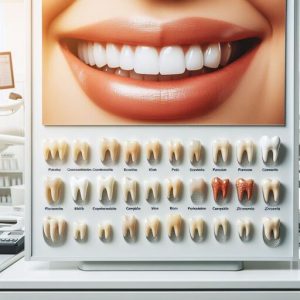Dental veneers have emerged as a sought-after cosmetic dentistry solution, providing a transformative option for individuals aspiring to enhance their smiles.
For those contemplating this procedure, acquiring a better understanding of the process, benefits, potential drawbacks, and post-treatment care is paramount.
If you find yourself desiring a positive transformation in the aesthetics of your smile, especially if issues like chipped, stained, or misaligned teeth contribute to self-consciousness, dental veneers may offer a viable solution.
Unsatisfied with the current state of your teeth?
This comprehensive guide is designed to furnish you with a thorough understanding of dental veneers, aiding in your decision-making process.
Dental veneers, whether crafted from porcelain or composite resin, are thin shells bonded to the front surface of your teeth, serving to enhance their shape, color, size, or alignment.
Dental veneers are like bonuses in an online casino: they offer an opportunity to improve a smile, hide flaws and get aesthetic comfort. These veneers can be compared to most volatile slots, where each game has its own unique capabilities. They are a solution for those who are not satisfied with the state of their teeth, providing ample opportunities to correct aesthetic problems.
This cosmetic dental procedure holds the potential to bestow upon you a more radiant and confident smile.
However, it is imperative to acknowledge that, like any procedure, dental veneers come with associated drawbacks and risks that merit careful consideration before reaching a decision.
Within this guide, we will delve into the essence of dental veneers, what they entail, their mechanics, the advantages and disadvantages they present, and the comprehensive expectations surrounding the procedure and its subsequent aftercare.
A case series study by Faezeh Hamzeh DDS, and fellow associates found that esthetic dental treatment using laminate veneers significantly affected oral health-related quality of life (OHQoL) enhancement in some aspects.
Table of Contents
ToggleWhat Are Dental Veneers?

Dental veneers are meticulously crafted from porcelain or composite resin and represent thin shells tailored to envelop the front surface of your teeth.
These custom-made shells are a versatile cosmetic dentistry solution that addresses an array of concerns related to tooth color, shape, size, or length.
Porcelain veneers, known for their durability and stain resistance, stand in contrast to composite resin veneers, which offer a more cost-effective and easily applicable option.
The choice between the two involves:
| Consideration Difference between Porcelain and Composite Resin Veneers |
| Considerations of longevity |
| Natural appearance |
| Financial investment |
These veneers serve as a transformative tool, capable of enhancing the aesthetic appeal of teeth by rectifying issues ranging from discoloration to misalignment.
Their application is a cosmetic remedy for concerns such as:
| What Veneers Fight Against |
|---|
| Discolored teeth from stains |
| Root canal treatment |
| Excessive fluoride |
| Large fillings |
Furthermore, they address chipped, broken, or worn-down teeth, as well as crooked, uneven, or irregularly shaped teeth and gaps or spaces between teeth.
Despite their versatile applications, dental veneers are not a universal solution. This permanent and irreversible procedure necessitates careful consideration, preparation, and ongoing maintenance.
Additionally, potential risks and limitations accompany the decision to opt for veneers.
This guide aims to furnish you with a comprehensive understanding of dental veneers, enabling you to make an informed decision about their suitability for your specific needs and preferences.
Let’s embark on this insightful exploration!
How do dental veneers work?
Dental veneers function as transformative agents, altering the shape, color, size, or alignment of teeth to address a spectrum of cosmetic concerns, including:
- Chipped, Cracked, or Worn-Down Teeth
- Discolored or Stained Teeth
- Crooked or Misaligned Teeth
- Gaps or Spaces Between Teeth
- Uneven or Irregularly Shaped Teeth
To undergo the dental veneer process, a visit to your dentist is essential for a consultation and the formulation of a treatment plan.
The procedure, contingent on the chosen veneer type, may require one or more appointments.
For porcelain veneers, a meticulous process unfolds. Initially, a thin layer of enamel is removed from your teeth to create space for the veneer.
Subsequently, an impression of your teeth is taken and dispatched to a dental laboratory for the fabrication of the veneers.
During the interim period, temporary veneers may be utilized for tooth protection.
Upon completion, the permanent veneers undergo scrutiny for fit and color before being bonded to your teeth with specialized cement.
Final adjustments and polishing are conducted as needed.
In contrast, the application of composite resin veneers involves surface roughening of your teeth, followed by the application of a bonding agent.
Layer by layer, the composite resin material is applied and shaped to achieve the desired appearance.
The material is then hardened using a curing light, after which trimming and polishing are executed for the final result.
Pros & Cons of Dental Veneers
Benefits:
Veneers usually offer a range of benefits. Some of the important ones are as follows:
| Benefits of Dental Veneers | Description |
|---|---|
| Enhanced Aesthetics and Boosted Self-Esteem | Dental veneers contribute to the improvement of your teeth’s appearance, fostering a positive impact on self-esteem. |
| Natural-Looking Results | Veneers provide a realistic and natural appearance, seamlessly blending with your overall smile. |
| Resistance to Stains and Decay | Veneers exhibit superior resistance to stains and decay compared to natural enamel, ensuring a prolonged aesthetic appeal. |
| Compatibility with Other Treatments | They complement various dental treatments, including whitening, braces, or implants, enhancing the versatility of cosmetic dentistry. |
| Minimally Invasive Procedure | The application of dental veneers is minimally invasive, often requiring little to no anesthesia during the process. |
Disadvantages:
While dental veneers offer numerous benefits it is essential to be aware of the drawbacks as well.
| Disadvantages of Dental Veneers | Description |
|---|---|
| Irreversible and Permanent | Once obtained, dental veneers are irreversible and permanently alter the original state of your teeth. |
| Financial Considerations | The cost of dental veneers is relatively high, and they are generally not covered by most dental insurance plans. |
| Susceptibility to Damage | Veneers may be prone to damage or breakage if subjected to biting on hard objects or if habits such as teeth grinding or clenching are present. |
| Potential Sensitivity or Discomfort | Enamel removal during the veneer application process or exposure to temperature changes may lead to sensitivity or discomfort. |
| Limited Lifespan | Veneers undergo wear and tear over time, necessitating replacement every 10 to 15 years for sustained efficacy. |
| Color Discrepancy Over Time | Changes in the color of your natural teeth due to aging or staining may result in a mismatch with the color of the veneers. |
The Types of Dental Veneers and How They Differ

There are different types of dental veneers available, depending on the material, design, and process of application.
The most common types are:
- Porcelain veneers
- Composite resin veneers
- No-prep veneers
Each type has its advantages and disadvantages, and its own price range.
Let’s take a closer look at each type and how they differ.
(Note: The prices mentioned are subject to change, as indicated by “*”)
| Veneer Type | Composition | Customization | Benefits | Drawbacks | Procedure |
|---|---|---|---|---|---|
| Porcelain Veneers: | Crafted from thin layers of porcelain, replicating the natural enamel appearance. | Tailored for each tooth, permanently bonded with specialized cement. | Lasts up to 15 years with proper care. Highly resistant to discoloration from food, drinks, or smoking. Mimics color, shape, and translucency of natural teeth. Does not cause allergic reactions or gum irritation. | Ranges from $1,000* to $2,500* per tooth. Requires enamel removal, potentially leading to sensitivity. Prone to chipping or cracking with forceful habits. | Examination, x-rays, impressions, and goal discussion. Removal of enamel, impression, temporary veneers. Check fit, color, cement application, bonding, polishing. Follow-up visit after a few weeks for assessment. |
| Composite Resin Veneers: | Tooth-colored resin material is directly applied and sculpted. | Custom-made for each tooth, no laboratory involvement. | Ranges from $250* to $1,500* per tooth. Little or no enamel removal, preserving natural structure. Easily repaired or modified if damaged or discolored. Completed in a single visit, saving time and cost. | Lasts up to 10 years or less. More prone to discoloration, and may need frequent polishing. May lack the natural look of porcelain veneers. May cause allergic reactions or gum irritation. | Examination, x-rays, impressions, and goal discussion. Cleaning, polishing, and application of composite resin. Layer application, shaping, trimming, polishing. Immediate evaluation with potential adjustments. |
| No-Prep Veneers: | Ultra-thin porcelain, minimal or no enamel removal. | Preserves natural tooth structure and sensitivity. | Preserves natural tooth structure. Can be removed without damaging teeth. No need for anesthesia or temporary veneers. Completed in two visits, saving time and money. | Ranges from $800* to $2,000* per tooth. Not suitable for all cases. Requires high skill from the dentist and laboratory. May create a thick or unnatural look, affecting speech or bite. | Examination, x-rays, impressions, and suitability assessment. Minimal or no enamel removal, impressions. Check fit, color, and shape, bonding. Monitoring for fit, color, shape, and potential adjustments. |
What to expect from the procedure and aftercare?
Dental veneers are thin, custom-made shells that are attached to the front surface of your teeth to improve their appearance.
They can change the color, shape, size, or length of your teeth, and create a natural-looking and beautiful smile.
Dental veneers can be used to treat various dental issues, such as:
- Discolored teeth due to stains, root canal treatment, excessive fluoride, or large fillings
- Chipped, broken, or worn-down teeth
- Crooked, uneven, or irregularly shaped teeth
- Gaps or spaces between teeth
If you are considering getting dental veneers, you may wonder what to expect from the procedure and aftercare.
In this article, we will explain the steps involved in getting dental veneers, the possible side effects and complications, and the tips and recommendations for taking care of your veneers and your teeth.
The Procedure for Getting Dental Veneers

Getting dental veneers is usually a painless and straightforward procedure that can be done in one or more visits to your dentist, depending on the type of veneers you choose.
The most common types of veneers are porcelain, composite resin, and no-prep veneers. Each type has its own advantages and disadvantages, and its own price range.
The procedure of getting dental veneers typically involves the following steps:
| Procedure | Description |
|---|---|
| Consultation | The dentist will assess your oral health, discuss veneer options, help you choose, and provide a post-veneer smile preview. |
| Preparation | For veneers, enamel may be removed, impressions sent for lab fabrication, and temporary veneers used. |
| Placement | When veneers are ready, they’re adjusted, cemented, and hardened. Excess cement is removed and the bite is checked. |
| Evaluation | Your dentist will have you assess your veneers and smile, make corrections, and provide care instructions. A follow-up visit may be needed to check your veneers and oral health. |
The Tips and Recommendations for Taking Care of Your Veneers and Your Teeth
Dental veneers can last for many years, depending on the type, quality, and care of your veneers and your teeth.
To prolong the lifespan and appearance of your veneers and your teeth, you should follow these tips and recommendations:
| Recommendations | Description |
| Brushing & Flossing | Brush and floss gently twice daily with a soft toothbrush and non-abrasive toothpaste to remove plaque and stains, and prevent decay and gum disease. |
| Rinsing | Rinse your mouth post-consumption, especially with staining foods or drinks, to remove residue and maintain oral hygiene. |
| Hard objects | Avoid using teeth on hard objects or as tools to prevent veneer damage. If you grind or clench your teeth, a night guard may be needed for protection. |
| Regular Consultation | Regular dental visits are needed for check-ups and maintenance. Your dentist will examine, clean, and adjust your veneers, and monitor your oral health. |
| Following Professional Advice | Follow your dentist’s advice on veneer care and maintaining your smile. Your dentist may suggest treatments like whitening, bonding, or sealants for enhancement or protection. |
Dental veneers are a cosmetic dental procedure that can improve the appearance of your teeth and smile.
Dental veneers are usually painless and straightforward, but they may also have some side effects and complications.
To get the best results and avoid any problems, you should always consult with an orthodontist and find out if dental veneers are right for you and what type of veneer would suit your needs and budget best.
You should also follow the tips and recommendations for taking care of your veneers and your teeth, and enjoy your new smile.
If you are interested in getting dental veneers, please fill out the contact form below and we will get back to you as soon as possible.











